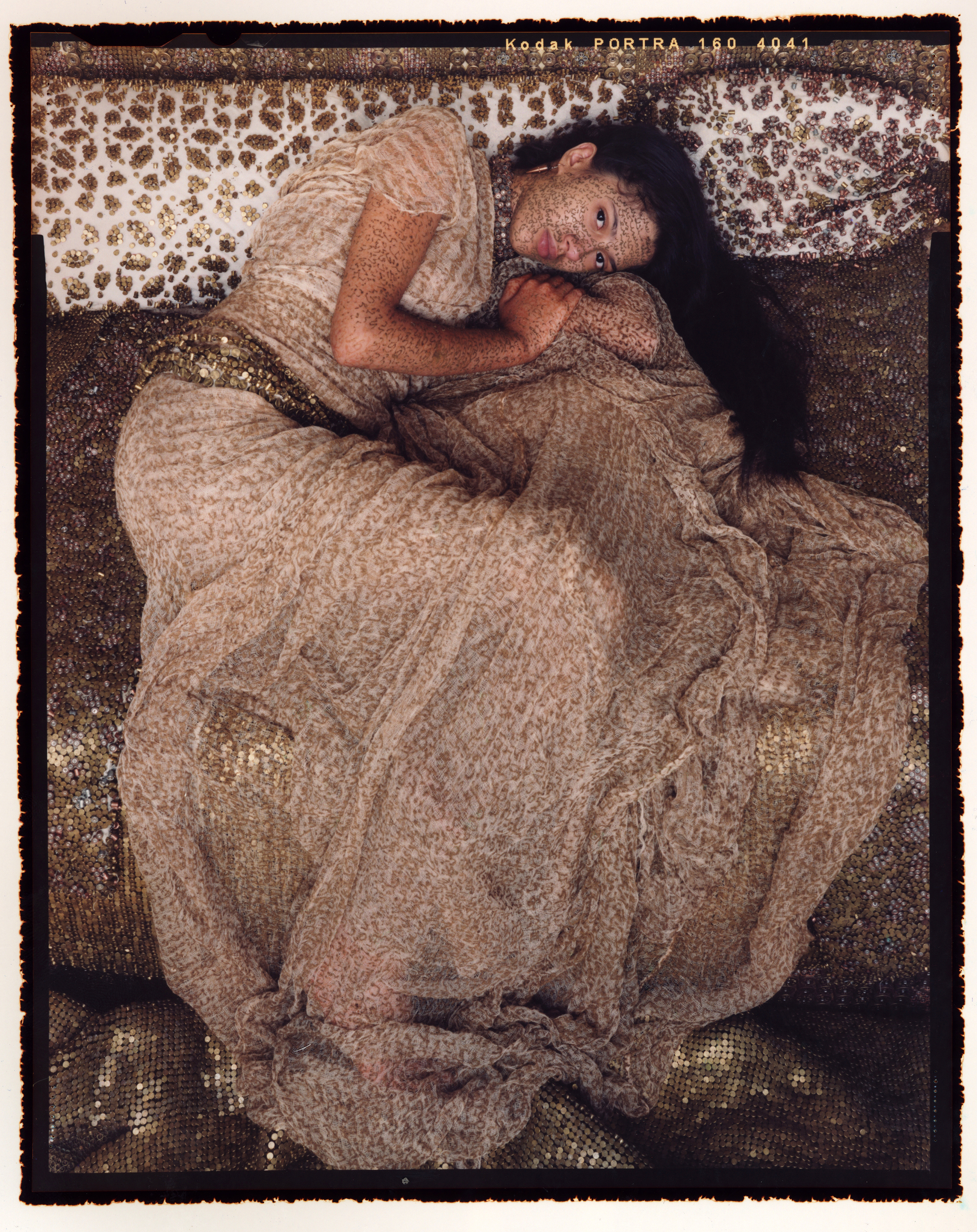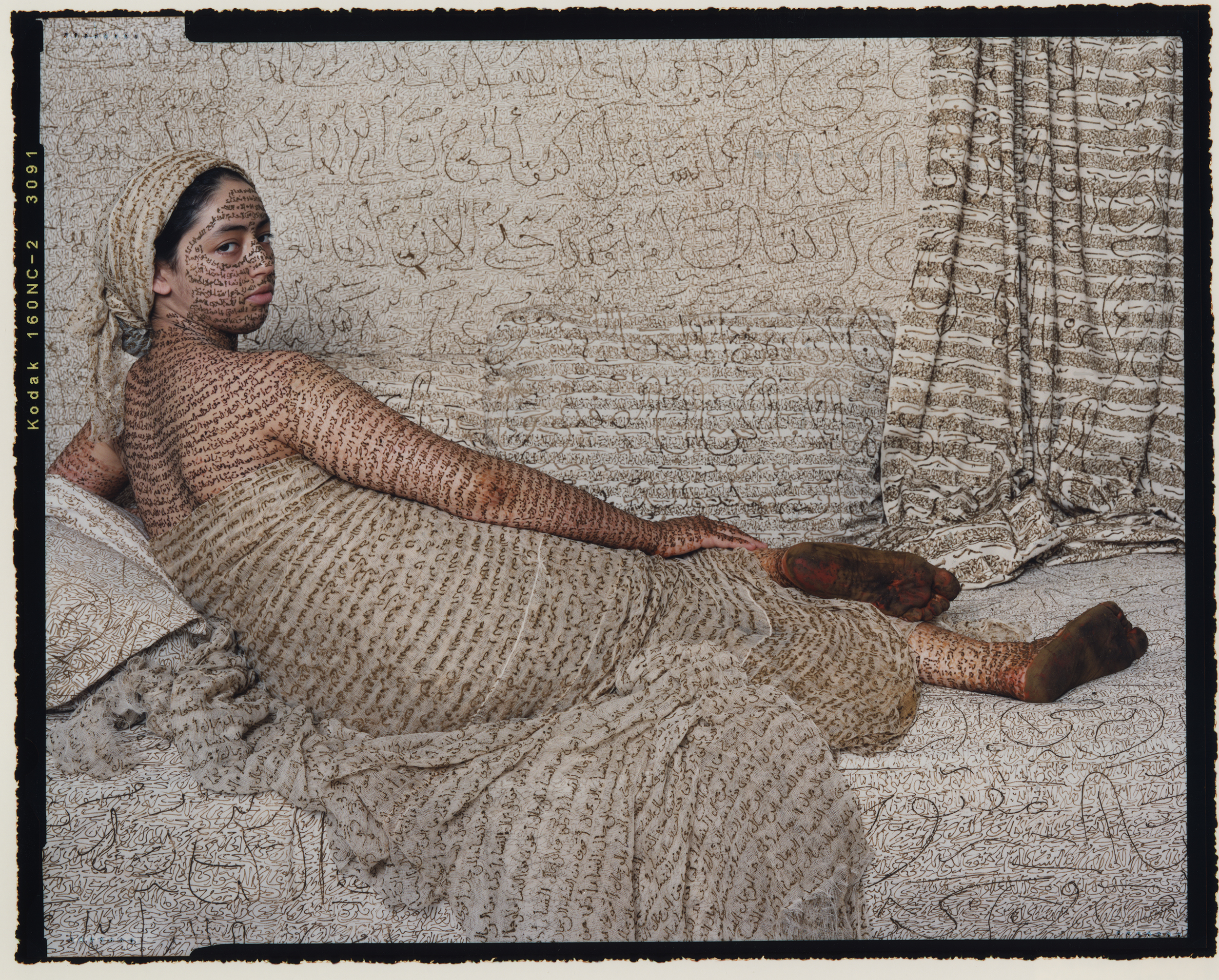
ラーラ・エッセイディ Harem #2(ハーレム #2)2009年 71 × 88 in 180.4 × 223.5 cm
モロッコ人アーティスト、ラーラ・エッセイディ(64歳)は、煌びやかで多次元的空間を喚起する写真で広く知られる。彼女の創作は、簡明な美しさを感じさせながらも、社会構造や女性のアイデンティティ、および文化的伝統の複雑性を浮き彫りにし、西欧の固定観念から生み出されるアラブ人女性の描写に挑戦する。
彼女 [1]の作品は、単に伝統的に受け継がれてきた表象を再考するだけではない。「オリエンタリズム絵画に描写された、オダリスクやベール、そしてもちろん、ハーレムなどに対し、西欧が抱いた憧憬を見る者に呼び起こそうとする」
彼女は、グローバル・ボイスとのインタビューでこう述べる。「私の作品は、主に、モロッコ人としてのアイデンティティを表しています。しかし、ベールやハーレム、華やかな装飾や煌びやかな色彩といった西欧の人々の目に象徴的にとらえられるものというのは、イスラム世界やアラブ世界の諸地域でも、視覚的に共鳴すると言えます。それは歴史をとおし、アラブ人女性は、主張を制限され、主体性を抑圧されてきたという一方的な見方が根強いことと関係しています」
モロッコで育ったエッセイディは、サウジアラビア [2]やフランスに住み、現在はボストンを拠点に活動している。これまでに、ワシントンD.C.の国立アフリカ美術館(National Museum of African Art)やシカゴ美術館(the Art Institute of Chicago)、オランダのフリース美術館(Fries Museum)などで作品を発表 [3]してきた。
彼女は、詩情ゆたかに建築物や女性の身体、そして色彩を映し出す詩人と言える。文字に圧倒される構図の中で、女性が放つ大胆な存在感とその瞳に宿る不安をとらえることにより、美のあらゆる方式を崩してゆく。
以下、インタビューより抜粋

モロッコ人アーティスト、ラーラ・エッセイディ(Photo courtesy of the artist.)
オミッド・メマリアン(以下OM):過去20年以上にわたって、あなたはご自身の作品をとおし、社会構造に疑問を投げかけ、権力や権威について自らの考えを述べる印象深い作品を創作されてきました。どのように、ご自身の声を視覚的に反映させる方法を生み出し、展開されてきたのですか?
Laila Essaydi: My approach to art in general, and my relation to Islamic art in particular, is deeply rooted in my personal experience. As a Moroccan-born artist who has lived in New York, Boston, and Marrakesh and who travels frequently to the Arab world, I have become deeply aware of how the cultures of the “Orient” and “Occident” view one another. In particular, I have become increasingly aware of the impact of the Western gaze on Arab culture.
Although Orientalism most often suggests a 19th-century European vision of the East, as a set of assumptions it lives on today: both in the gaze of the West and in the way Arab societies continue to internalize and respond to that gaze. In its early form, Orientalism was a literal “vision,” finding expression in the work of Western painters who traveled to the “exotic” East in search of cultures more colorful than their own, I have used it as a point of departure in much of my own work—in both painting and photography.
The imagery I found in Orientalist painting has resonated with me in tricky ways and ultimately helped me situate my own experience in a powerful visual language.
In my photography, I explore this space, whether mental or physical, and interrogate its role in gender identity-making, while engaging with centuries of cultural heritage and artistic practices. For instance, my images of women, embedded in Islamic architecture, recognize and represent an alternative to similar spaces, as imagined for women, in painting and photography, from within the Arab and Muslim worlds. My fusion of calligraphy (a sacred art traditionally reserved for men) and henna (an adornment worn and applied only by women) similarly reproduces artistic traditions and practices common in everyday life in Islamic cultures while transgressing gender roles and the boundaries between private and public spaces.
ラーラ・エッセイディ(以下LE):アート全般に対する私の取り組みや、特にイスラム美術との関わりは、私自身の個人的な経験に深く根付いていると言えます。ニューヨークやボストン、マラケシュに住み、アラブ諸国を頻繁に訪れるモロッコ生まれのアーティストとして、私は「東洋(オリエント)」と「西洋(オクシデント)」という概念における互いの文化の見え方を意識するようになりました。特に、西欧からの眼差しによるアラブ文化への影響を強く意識するようになったのです。
オリエンタリズムというのは、一般的に、19世紀のヨーロッパの人々が思い描いた東方世界の姿と考えられていますが、今も尚、西欧の人々に浸透する先入観の総体として引き継がれています。そして、それは、西欧の眼差しに投影されたり、アラブ社会が西欧からの眼差しを内在化することにより、西欧からの一方的な視線にアラブ社会の人々が応え続けるという思考様式にも見受けられたりします。初期のオリエンタリズムは文字どおりの「ヴィジョン」として、西欧の文化よりも色彩豊かな文化を求め「エキゾチック」な東洋を旅した西欧の画家の作品に描かれてきましたが、私は、絵画と写真の双方を表現手段に、作品の大部分でオリエンタリズムを出発点として展開してきました。
オリエンタリズム絵画から感受したイメージは、私の体験と複雑に絡み合い、最終的に自らの経験を強力な視覚言語として位置づける後押しとなったのです。
私は自らの創作を介し、何世紀にもわたる文化遺産や芸術活動を考察し、精神的、身体的境界線を問わずこの空間を探り、ジェンダー・アイデンティティ形成という観点からジェンダーの役割について問いかけているのです。たとえば、イスラム建築に埋め込まれた私の女性像は、一般に、アラブ世界やイスラム世界を背景に、絵画や写真の中でモチーフとされる女性から西欧の人々が連想する空間を代替的に創りあげることで表しています。
私の作品では、カリグラフィー(伝統的に男性だけに許される宗教美術)とヘナ(女性だけに施される染料を用いた身体装飾)を融合し、イスラム文化圏の日常生活で見られる芸術的伝統や慣習を再現しながら、ジェンダーの役割や私的な空間と公の空間の境界線を越えてゆくのです。

ラーラ・エッセイディ Harem #1(ハーレム #1)2009年
OM:あなたはモロッコで生まれ育ち、19年間サウジアラビアで過ごしたのちにパリに移り美術を学ばれ、最終的に、アメリカへ渡って勉強され暮らされています。各国で生活されてきたことは、あなたの創作や女性に対する認識、また、作品の中の女性の存在感にどのような影響を与えましたか?
LA: My work is inspired by personal history. The many territories that converge in my work are not only geographical ones but territories of the imagination, shaped, above all, by childhood and memory—by these invisible influences. My work cannot be reduced to Orientalist discourse. Orientalism has given me a lens through which to focus on the converging territories of my work and through which to see more clearly the influence of Western imagination in the Eastern ways of conceptualizing the self. At a more personal level, my creative practice is a means through which I can reinvent and position myself in different times and cultural contexts.
At the same time, I also celebrate the cultural richness of Morocco, the Middle East and North African countries. Although I tend to think of my work as, first and foremost, being about the experience of women, I would say that these elements are also significant. They do not happen incidentally but are part of the inherent qualities that I bring to my vision and my work.
LE: 私の作品は、自分の個人的な経験からインスピレーションを受けています。創作をとおし、私の人生の軌跡として再び、ひとつに収斂(れん)してゆく多くの領域は、地理的なものだけではなく、想像性の領域にまでわたり、それは何よりも幼少期や記憶によって形づくられた、目に見えない影響を受けた部分でもあるのです。私の作品は、オリエンタリズムの言説に回帰するものではありません。オリエンタリズムというレンズを通し、私が作品群として形にした、収斂してゆく領域という空間にカメラを向けることにつながり、アラブ社会の女性が東洋的自己像を形成する上での、西欧の一方的な想像による影響をはっきりと認識することになったのです。より個人的なレベルで言うと、私の創作活動というのは、異なる時代や文化的背景の中で自分自身を再定義し、新たに位置づけるための手段なのです。
同時に、私はモロッコや中東、北アフリカ諸国の文化的豊かさを誇らしくも思うのです。私の創作は何よりも女性としての経験を軸に展開されるものとして考えてしまいますが、これらの地域に見られる文化的豊さもまた意義深いことだと言えます。それらは偶然に見出されたものではなく、私のヴィジョンと作品に内在する資質の一部なのです。

ラーラ・エッセイディ Bullets Revisited(弾丸再考 #37) 2014年
OM:タフツ大学及びボストン美術館の付属美術大学でBFA(美術学士号)とMFA(美術修士号)を取得されたことで、どのようにあなたのキャリアや芸術面での変容を後押しすることになりましたか? また、大学での教育はあなたが期待したとおりのものでしたか?
LE: I enrolled in the Museum School because I wanted to return to Morocco and be able to pursue my hobby with greater knowledge and skill. Instead, I found my life’s work.
I learned that some of the most important things in our lives happen unexpectedly. We take a class in painting and discover an entire new world at our fingertips: waiting to be grasped. We take a class in painting and find art history, and installation, photography and so much more. We look for a glass of water and find an ocean, calling to us. And we answer the call.
I never dreamed I would spend seven years in this environment, immersing myself in everything the School had to offer, and learning more than I had ever imagined was possible.
This was, and is, a school of artists, designed by and for artists: where students are free to choose what they want to learn. It only offers elective modules, and there are no mandatory classes. When we realize the riches that are available, we want to absorb everything.
At first I was overwhelmed. I was one of those students who roamed the corridors of the School late at night, peering into the empty rooms, with their silent trappings of whatever medium was taught there.
Eventually, the School taught me a second lesson. With all these opportunities and this great array of artistic riches, with this enormous freedom to choose, comes responsibility.
Responsibility first means discipline, and setting priorities, followed by learning new skills and techniques. And then comes self-direction, as we learn and understand new ways of thinking about art, and the ambition to do something important with our lives.
My career offered me something else, something I did not expect. This very public environment offered me a private space, something I had never had at home. It offered me a space where I was free to express my thoughts in private, without the inhibiting knowledge that they were available for all to see. This enabled me to explore and bring to the fore aspects of my own interior life I hadn’t even known were there.
While I knew that creating art is an intensely personal experience, I also learned that it happens only with the help of a lot of gifted and dedicated people: people who teach and guide, people who encourage and nurture, people who inspire you to keep reaching to create what is excellent and beautiful and true. You can tell, I loved the School.
LE: 私が美術大学に入学したのは、モロッコに戻り、より幅広い知識とスキルを身につけることで自分の趣味を突き詰めてみたいと思ったのがきっかけです。そこで代わりに、生涯の仕事に出会うことになりました。
人生の転期となることの中には、予期せず起こることがあるということを知りました。たとえば、絵画を学びに行き、把握されるのを待ちわびる、自らの指先から出現する新しい世界を発見することがあります。また、美術史やインスタレーション、写真といったもっと多くのことを知ることだってあります。一杯の水を求めて、私たちを呼びかける海を見いだし、呼応するように道が開かれていくのです。
こうした環境で7年間を過ごし、学校から課されたすべてのことに没頭し、想像以上のことを学ぶことができるとは夢にも思っていませんでした。
これは、アーティストによるアーティストのためにつくられた、アーティストの学校なのです。ここでは、学生は選択科目のみ選ぶことができ、必修科目はありません。豊かさを実感するとすべてを吸収したくなります。
最初は圧倒されました。夜遅くまで学校の廊下を歩き回って誰もいない教室を覗き込み、そこで教えらた素材が何であろうと、空っぽの教室に飾られた無言の装飾の気配を感じながら過ごす生徒の一人でした。
結果的に、学校に通うことで私は第二の教訓を得ることになりました。このような機会と芸術的豊かさ、選択の自由があればあるほど責任が伴います。
第一に、責任を持つということは、規律と優先順位をつけることであり、続いて、新しい技術や技法を習得します。そして、芸術についての新しい考え方を学んで身につけ、自分の人生で何か意義のあることをしようという野心を持つことにより、自らの進むべき方向性を決めるのです。
私は自分のキャリアを通じて、何か他の思いもよらなかった何らかのものを得ることになりました。私はこの非常に公の環境で、これまでの自宅には存在しなかった何か私的な空間というものを体験したのです。それは、発言に対する周りの目に萎縮することなく、思ったことを私的に自由に表現できる空間を得ることになったのです。こうした体験により、本人でさえも気づくことのなかった自分の潜在意識を探り、それが浮き彫りになったのです。
芸術を生み出すということは、非常に個人的な経験であることを知っていましたが、それは多くの才能ある献身的な人々の助けがあってこそ成り立つことも学びました。教え、導いてくれる人、励まし、育ててくれる人、素晴らしく美しく真のものを創造するために手を伸ばし続けるようにあなたを鼓舞してくれる人。私は学校が大好きだったと、そう伝えることができますね。

ラーラ・エッセイディ Les Femmes du Maroc: La Grande Odalisque(モロッコの女性たち: オダリスク)2008年
OM:アラブ世界の女性や彼女たちの私的空間は「ハーレム」シリーズの中核になっています。こうしたモチーフへの好奇心や、それらに着目することになったきっかけを教えてください。また、創作の中で扱われるモチーフは時代とともに変容していきましたか?
LE:LE: My work reaches beyond Islamic culture as it also invokes the Western fascination with the odalisque, the veil, and, of course, the harem as it is expressed in Orientalist painting. Orientalism has long been a source of fascination for me. My background in art is in painting, and it is as a painter that I began my investigation into Orientalism. My study led me to a much deeper understanding of the painting space so beautifully addressed by Orientalist painters in thrall to Arab décor. From its terrific prominence in these paintings, this décor made me keenly aware of the importance of interior space in Arab/Islamic culture. And finally, of course, I became aware of the patterns of cultural domination and predatory sexual fantasy encoded in Orientalist painting.
LE:私の作品は、イスラム文化という境界線を超えるものです。オリエンタリズム絵画に描写された、オダリスクやベール、そしてもちろん、ハーレムなどに対し、西欧が抱いた憧憬を見る者に呼び起こそうとしているのです。長い間、オリエンタリズムは私にとっての魅力の源泉でした。私の美術の専門は、絵画なので、オリエンタリズムの研究を始めたのも、画家としての探究心によるものでした。この研究を進めるなかで、アラブ世界の装飾様式に魅せられたオリエンタリズムの画家が美しく描きあげた絵画空間について、さらに理解を深めることになりました。また、オリエンタリズム絵画の中に見られる豊な装飾性に注目し、アラブ・イスラム文化における室内空間の重要性を痛感したのです。そして、最後に言うまでもありませんが、オリエンタリズム絵画に内包された文化的優位性や、権威的で幻想的な官能性のパターンにも気づくようになったのです。
OM:あなたの作品には、複層的な意味が込められています。表層は美しく色彩豊かに彩られ、カリグラフィーやヘナ、陶器タイル、文様などが魅力的にひとつの空間へと溶け込んでゆきます。作品を前に、この空間の簡明な美しさに目を奪われますが、それは、見る者を躍動感あふれる神秘的な視覚的迷宮へと誘い込むように感じられます。こうした絶妙な境を操るのはどんな感じですか?
LE::It is important for me that my work be beautiful. While it is received very differently in Western and Arab contexts, its aesthetic is appreciated in both. More critical for me, however, is that the photographs achieve a balance between their political, historical and aesthetic content, as well as make a statement on art.
But the fact that I have sometimes been critiqued for, on the one hand, perpetuating expectations and stereotypes rather than refuting them and, on the other, for exposing that which should remain private, indicates that responses to my work are highly subjective, context-specific and likely culturally informed. Tempered by the ambiguity of the work’s literal meaning, perhaps defaulting to the most accessible and intuitive reaction: perception of the stereotype. Nevertheless, with deliberate subtlety, my work introduces alternative, challenging perspectives on canonical 19th-century Orientalist paintings. As a female artist from the regions depicted, mine is an historically repressed voice that “complicates any neat framing of the canon.” Drawing on similar visual devices, I try to engage it in an unfamiliar and uncomfortable dialogue, and re-situates the Orientalist genre in the history of art.
LE:私にとって、自分の作品が美しくあることは大切なことです。私の作品の受け取られ方は、西欧の文脈とアラブ世界の文脈では大きく異なりますが、作品の美学という点では両者で評価されています。しかし、私にとってさらに重要なのは、作品の中で、政治的、歴史的、美学的内容のバランスがとられながらも、芸術に声が反映されているということです。
しかし、一方では、幻想や固定観念を否定することなく永続させていると言われ、また、他方では、私的な空間として留めるべきものをさらしたと批判を受けることがあります。それは、私の作品に対する受け止め方というものが、極めて主観的であり、また文脈に依存し、おそらく文化的背景に基づいたものであることを物語っているのです。
彼らは、再考として表された作品の文字通りの意味と、自らの意識とのあいだに起こる、観念的な矛盾を埋め合わせようと、おそらく最も単純明快であり、また直感的な自らの反応を型にはめて読み解こうとするのです。それは、まさに固定観念による眼差しと言えるのです。しかし、私は、注意深く、そのわずかな意識のすき間に入りこむことで、規範的な19世紀のオリエンタリズム絵画の視点を覆し、新しい見方を提示しているのです。アラブの女性アーティストとしての私の作品というのは、歴史的に抑圧されてきた声を表すものであり「規範となる均整の取れた枠組みをも複雑化させる」ことに狙いがあるのです。同じような視覚的な読み解きにより、ひねりを加えた自分の作品をこれまでにない新しい対話へと結びつけ、オリエンタリズムというジャンルを美術史の中に再配置しようとしているのです。

Harem Revisited #34(ハーレム再考 #34)2012年
OM:2012年のインタビューで、あなたの作品に起用されているモデルは「自分たちを小さなフェミニズム運動の一員だと思っている」と述べていました。「自由」というは、あなたが主に関心を寄せているもののひとつですが、作品の多くであなたは伝統を再構築しているように見受けられます。この一見、矛盾した公式というのは、どのようにしてこのような解放性を生み出しているのでしょうか?
LE::My work may seem to “reconstruct traditions,” but in fact I am trying to create a new understanding.
The liberating result comes because in many ways, performance is an intrinsic element of my photographs, evident in the figures’ careful composition, in the physical act of writing and, more importantly, in the intensity of the sitters’ embodied presence that also renders them subjects rather than objects.
Through writing, I lay bare personal thoughts, memory, and experiences that belong to me and the women featured as individuals within a broader narrative. Though my work speaks primarily in terms of Moroccan identity, visual identifiers such as the veil, harem, ornate ornamentation, and sumptuous color also resonate with other regions in the Muslim and Arabic worlds where the place of women has historically been marked by limited expression and constrained individuality.
While my work evokes the region’s traditional aesthetics and social practices, I insert a dimension that complicates them: a personal narrative that takes form in the written word. In volumes upon volumes of text, these women voice critical reflections on and interrogations of memories, all captured within the space of my photographs. At the same time, I write about historical representations of Moroccan, Arabic, Muslim, and African women. To understand my work, then, one must examine long-standing preconceptions held by diverse peoples over time, as well as by myself.
LE: 私の作品は「伝統を再構築する」というように見えるのかもしれませんが、実際には新しい解釈を生み出そうとしているのです。
解放性が感じられるのは、色んな意味で、パフォーマンスというのが私の写真の本質的な要素であることに関係しています。たとえば、綿密に考え抜かれた人物構図や文字を書くという身体的行為からも見てとれると思います。そして何よりも重要なのは、女性が物のように対象化されるのではなく、自ら被写体となり、フェミニズム運動の一員として誇りを持つことにより、圧倒的な存在感となって示されてもいるということなのです。私は、ヘナ染料を使い、写真に文字を書くという行為により、私自身や、壮大な物語の中の個人である女性の私的な思いや記憶、経験の覆いを取り払おうとしているのです。私の作品は、主に、モロッコ人としてのアイデンティティを表しています。しかし、ベールやハーレム、華やかな装飾や煌びやかな色彩といった、西欧の人々の目に象徴的にとらえられるものというのは、イスラム世界やアラブ世界の諸地域でも、視覚的に共鳴すると言えます。それは歴史をとおし、アラブ人女性は、主張を制限され、主体性を抑圧されてきたという一方的な見方が根強いことと関係しています。
私の作品は、見る者に、これらの地域の伝統的美学や社会的慣習を思い起こさせる一方で、伝統的価値観を複雑にする側面を織り交ぜているのです。それは、男性だけに許されたカリグラフィーと女性が用いるヘナ染料を融合することで読み解かれる女性の私的な物語でもあるのです。膨大な文字に埋め尽くされながらも、女性は、批判的考察や記憶への問いかけを声にし、私の創造する写真という空間で、全ては記録に収められるのです。そして同時に、私は、モロッコやアラブ世界、イスラム世界やアフリカ諸国などの女性の歴史的表象性についても写真に記しています。ですから、自らの創造性というものを知るには、私自身の中にある先入観だけでなく、時代を超えて多様な人々が抱いてきた長年の先入観を検証する必要性があるのです。

ラーラ・エッセイディ Bullets(弾丸)2017年2月3日から4月15日までJackson Fine Art [4]にて
(訳注:現在、フェアフィールド大学美術館 (Fairfield University Art Museum [5])にて、ラーラ・エッセイディによる展覧会「By Design: Theater and Fashion in the Photography of Lalla Essaydi」を開催しています。期間は、2021年1月29日から5月21日まで)